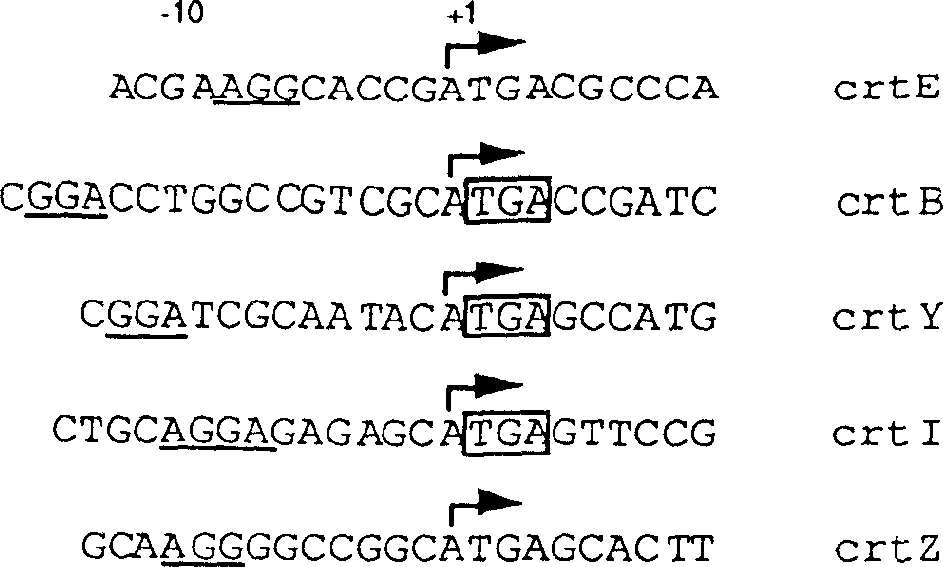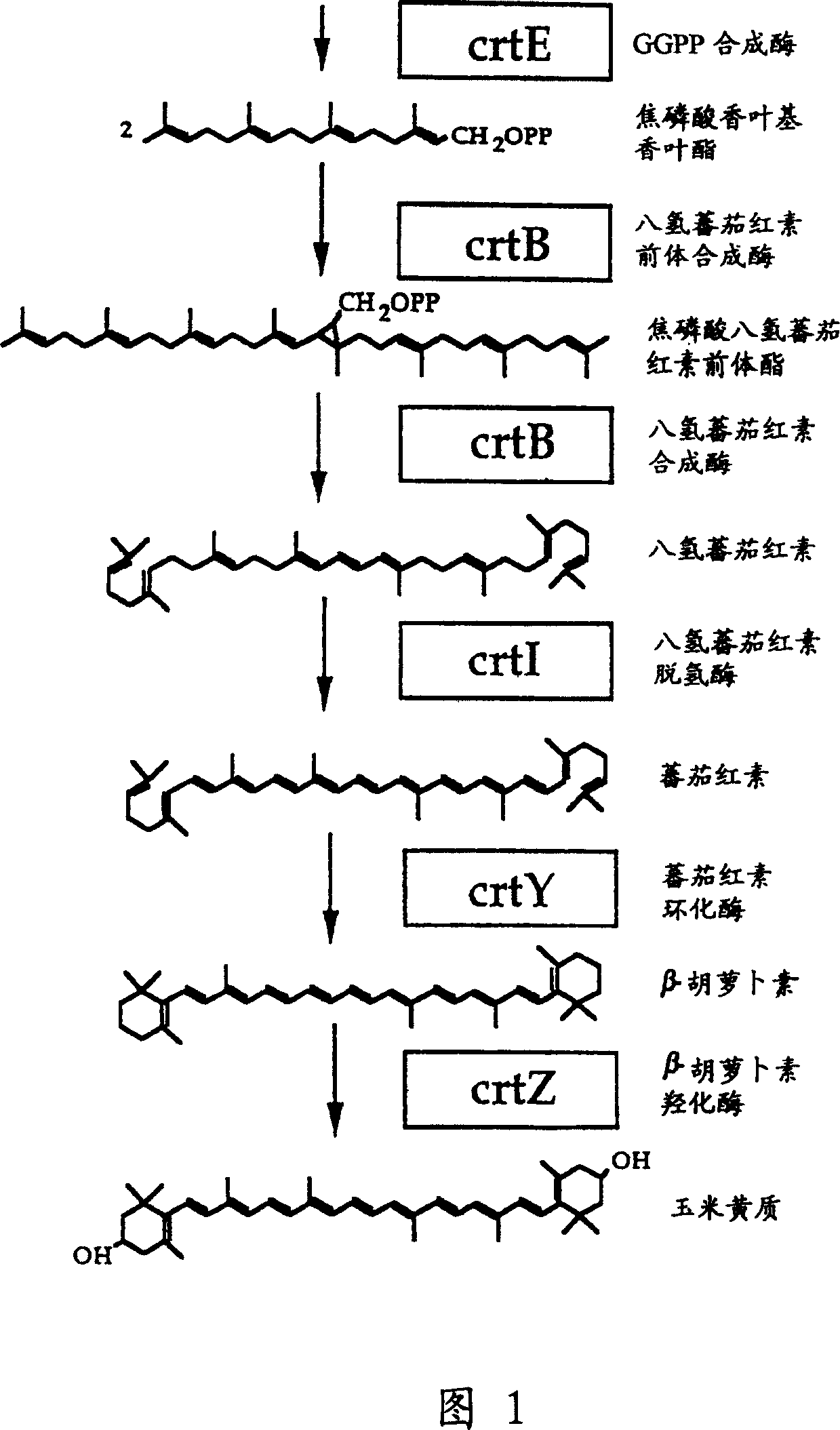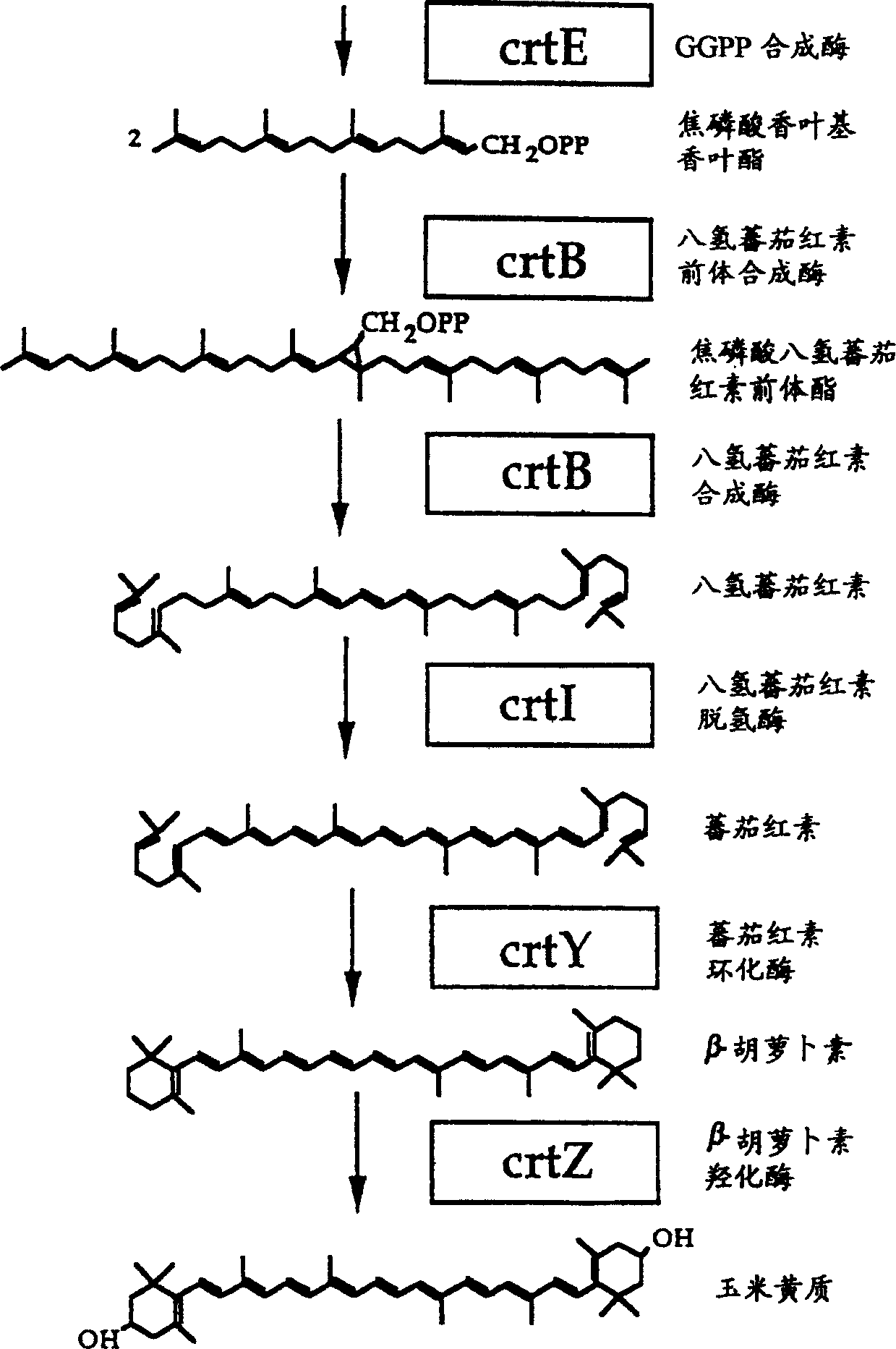Fermentative carotenoid production
A technology of carotene and lycopene, applied in fermentation, microorganisms, sugar derivatives, etc., can solve the problem of undiscovered crtW gene functional activity combination
- Summary
- Abstract
- Description
- Claims
- Application Information
AI Technical Summary
Problems solved by technology
Method used
Image
Examples
Embodiment 1
[0126] Materials used and general methods
[0127] Bacterial Strains and Plasmids: Flavobacterium R 1534 wild type (ATCC 21588) was the DNA source for the cloned genes. The partial genome library of Flavobacterium R 1534 wild-type DNA was constructed into pBluescriptII+ (KS) or (SK) vector (Stratagene, La Jolla, USA), and transformed into E.coli XL-1 blue (stratagene) or JM 109.
[0128] Media and growth conditions: Transformed E. coli were grown at 37°C in Luria broth supplemented with 100 μg ampicillin (Amp) / ml for selection. Flavobacterium genus R1534 wild-type at 27 ° C, in the presence of 1% glucose, 1% tryptone (Difco Laboratories), 1% yeast extract (Difco), 0.5% MgSO 4 ·7H 2 Grow in O and 3% NaCl medium.
[0129] Colony screening: using the following primers, E. Coli transformants were screened by PCR method basically according to the method of Zon et al. [Zon et al., Biotechniques7, 696-698 (1989)]:
[0130] Primer # 7: 5′-CCTGGATGACGTGCTGGAATATTCC-3′
[0131] ...
Embodiment 2
[0142] Cloning of the Carotenoid Biosynthesis Gene of Flavobacterium R 1534
[0143] To identify and isolate DNA fragments carrying genes of the carotenoid biosynthetic pathway, the inventors used DNA fragment 46F (see Methods section) to probe the chromosomal DNA of Flavobacterium R 1534 species digested with different restriction enzymes Southern blot (Figure 2). The 2.4 kb XhoI / PstI fragment that hybridized to this probe appeared to be the most suitable fragment to start with. Genomic Flavobacterium R1534 DNA was digested with XhoI / PstI and electrophoresed on a 1% agarose gel. A region of approximately 2.4 kb on the gel was excised based on comigrating DNA markers and the DNA was isolated. The XhoI / PstI minigene library of Flavobacterium R 1534 genomic DNA was constructed into the XhoI-PstI site of pBluescriptIISK(+). Then 100 E.Coli XL1 transformants were used with primers # 7 and primers # 8 (the same primers used to obtain the 119bp fragment (46F) above), were scr...
Embodiment 3
[0175] Materials and methods for the expression of carotenoid synthases
[0176] Bacterial strains and plasmids: Use vectors pBluescriptIIKS (+) or (-) (Stratagene, La Jolla, USA) and pUC18 [Vieira and Messing, Gene 19 , 259-268 (1982); Norrander et al., Gene 26 , 101-106 (1983)] in different E. coli strains, such as XL-1 blue (Stratagene), TG1 or JM 109 for cloning. In all Bacillus subtilis transformations, strain 1012 was used. Plasmid pHP13 [Haima et al., Mol. Gen. Genet. 209 , 335-342(1987)], and plasmid p602 / 22 [LeGrice, S.F.J.in Gene Expression Technology, Go-eddel, D.V.Editot, 201-214(1990)] are capable of replicating in Bacillus subtilis and E.Coli cells Gram(+) / (-) shuttle vector. Plasmid p205 contains the VegI promoter cloned into the SmaI site of pUC18. Plasmid pXI12 is an integrating vector for constitutive expression of genes in Bacillus subtilis [Haiker et al., in 7th Int. Symposium on the Genetics of Industrial Microorganisms, June 26-July 1, 1994, Mongre...
PUM
| Property | Measurement | Unit |
|---|---|---|
| molecular weight | aaaaa | aaaaa |
| molecular weight | aaaaa | aaaaa |
| molecular weight | aaaaa | aaaaa |
Abstract
Description
Claims
Application Information
 Login to View More
Login to View More - R&D
- Intellectual Property
- Life Sciences
- Materials
- Tech Scout
- Unparalleled Data Quality
- Higher Quality Content
- 60% Fewer Hallucinations
Browse by: Latest US Patents, China's latest patents, Technical Efficacy Thesaurus, Application Domain, Technology Topic, Popular Technical Reports.
© 2025 PatSnap. All rights reserved.Legal|Privacy policy|Modern Slavery Act Transparency Statement|Sitemap|About US| Contact US: help@patsnap.com



